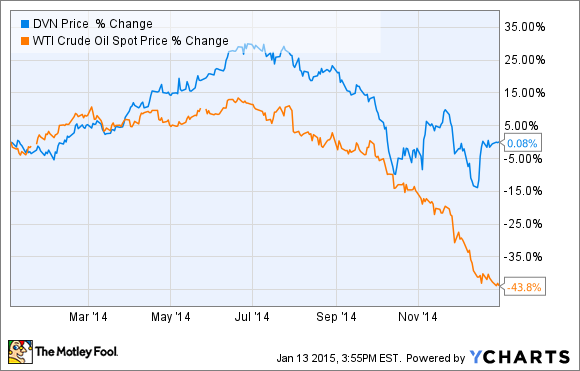Devon Energy Corporation's (DVN 0.58%) stock took its investors on a wild ride last year. However, when all was said and done the stock basically ended the year where it started as we see here.
While a 0.08% return is nothing to celebrate, given the abysmal returns of most other oil stocks investors will likely take what little they got from Devon Energy last year. Here's a closer look at why the company was able to stay in the black while so many other oil stocks fell deeply into the red last year.
Flying like an Eagle
Devon Energy's successful year was set up by the two moves it made in late 2013. The first move was to merge its midstream assets with another MLP to create the EnLink Midstream companies, which include MLP EnLink Midstream Partners LP (NYSE: ENLK) and General Partner EnLink Midstream LLC (ENLC 0.44%). Shortly thereafter the company spent $6 billion to buy oil and gas assets in the Eagle Ford Shale. That deal provided the company with another oil growth platform, which it used to drive results in 2014.
This was quite evident in the company's first quarter report where Devon Energy's earnings surged 103% over the prior year and handedly beat estimates. The company's management specifically pointed to the success of its newly acquired Eagle Ford Shale assets, which helped the company to deliver "outstanding oil production growth" and enhanced profitability" according to comments from CEO John Richels that quarter.
Second quarter results were also very strong as oil production growth from the Eagle Ford Shale again fueled the company's earnings. In fact, while production from that play was in line with its robust expectations, it would have been even better if the company didn't have issues with a third-party gathering system, which experienced some downtime forcing Devon to shut-in production.
Finally, the Eagle Ford Shale again shined in the company's third quarter report. The company noted that production from that play was up 76% since it took over operations in March of 2014. That strong production, as well as a robust outlook, provided the company the fuel it needed to beat earnings estimates and to raise its full-year guidance.
Momentum is out of gas, but its foundation is strong
The company's operational momentum led to a surging stock price until oil prices rolled over. As the following chart shows the company's stock was up well over 25% at one point, but oil's gravitational pull erased those gains when it rolled over in late summer.
Because Devon Energy's growth is tied to its oil assets in the Eagle Ford Shale, Permian Basin and Canadian oil sands it had the wind knocked out of its sails when the price of oil collapsed.
That being said, its stock price isn't down nearly as far as most other North American oil companies for one big reason, its balance sheet is rock solid. In fact, as of the end of the third quarter its balance sheet was not only investment grade rated, but it also had a massive $3.4 billion cash balance to go with just $6.8 billion in debt. This is in stark contrast to many rivals, which could end up going bust if low oil prices persist. Investors really see Devon Energy's stock as a safe haven amid an industry that now seems heavily weighed down with debt.
Investor takeaway
While Devon Energy produced a meager return in 2014, it really outperformed expectations on the year. Because of that its stock would have likely ended the year a lot higher if oil prices didn't collapse. That said, the collapse in oil prices could actually be a blessing in disguise as it might open up new doors for Devon Energy to use its strong balance sheet to buy out weaker rivals so that it can really thrive whenever oil prices recover.






